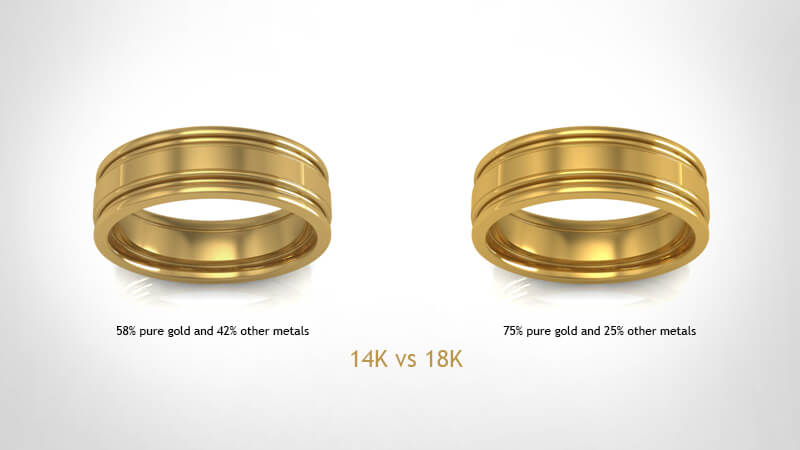Introduction
Gold has always held a special place in our hearts and our jewelry boxes. But did you know that not all gold is created equal? If you're pondering whether to go for that stunning 14k or 18k gold necklace, it's crucial to understand the key differences between these two popular choices. What's the deal with these 'k' values, and how do they affect your jewelry? Allow us to break it down for you in this comprehensive guide to the difference between 14k and 18k gold jewelry.
Purity vs. Durability: The Gold Dilemma
Purity: The 18k Gold Charm
Ah, 18k gold – the charmer of the jewelry world. It's renowned for its higher purity compared to 14k gold. When we say purity, we're talking about the percentage of gold in the alloy. In the case of 18k gold, it's a dazzling 75% pure gold. This is why it's sometimes referred to as "75% gold." The remaining 25% is usually composed of other metals like silver, copper, or nickel, which lend their unique qualities to the final product.
Shine Bright Like an 18k Diamond
One of the key advantages of 18k gold's higher purity is its striking, rich color. It exudes a warm, lustrous glow that makes it ideal for jewelry pieces such as engagement rings and earrings. When you wear an 18k gold necklace or bracelet, you're donning a piece that radiates elegance and luxury.
Durability: The 14k Gold Survivor
Now, let's talk about the rugged survivor in the gold jewelry world – 14k gold. It's known for its durability. The 'k' stands for karats, and in the case of 14k gold, it means that it's 58.3% pure gold, with the remaining 41.7% consisting of alloys. This lower gold content might lead you to believe that it's of lesser quality, but don't jump to conclusions just yet.
Tough as Nails
14k gold's durability is one of its strongest suits. Its alloy composition makes it more resistant to scratches and dings compared to 18k gold, which is relatively softer due to its higher gold content. This durability is particularly appealing for jewelry items that undergo everyday wear and tear, such as wedding bands.
The Purity-Durability Trade-Off
Here's the catch: 18k gold's higher purity may make it more susceptible to surface scratches and dents. This means that while it's a top pick for show-stopping pieces, you might want to think twice about an 18k gold bracelet you plan to wear daily.
Conversely, 14k gold's lower purity may lead to a slightly less radiant appearance than its 18k counterpart. However, its durability makes it an excellent choice for pieces that withstand daily activities. It's all about finding the right balance for your lifestyle and preferences.
Appearance and Color: Radiance Revealed
The Allure of 18k Gold
If you're seeking jewelry that exudes a warm and radiant glow, 18k gold is your answer. Its higher gold content allows it to shine with a vivid, yellowish hue that's often associated with luxury and opulence. This makes it a top choice for statement pieces like cocktail rings and pendants.
Subtle Elegance of 14k Gold
On the other hand, 14k gold offers a more understated elegance. It has a slightly paler color compared to 18k gold, making it an excellent choice for those who prefer a more subtle, refined look. The color of 14k gold complements a wide range of gemstones and is a popular choice for engagement and wedding rings.
The Versatility Factor
The choice between 14k and 18k gold isn't just about personal taste; it's also about versatility. The paler shade of 14k gold allows it to pair effortlessly with various gemstones and jewelry styles, making it a go-to option for everyday wear. Meanwhile, 18k gold's rich color makes it perfect for bold, eye-catching pieces that steal the show.
Pricing: The Wallet's Perspective
Cost of Luxury: 18k Gold
Luxury often comes at a price, and the same applies to 18k gold jewelry. Its higher gold content and rich appearance generally make it more expensive than its 14k counterpart. When you invest in 18k gold, you're investing in a piece that exudes extravagance and craftsmanship.
14k Gold: Affordable Elegance
If you're looking for a budget-friendly option without compromising on quality and style, 14k gold is your best friend. It provides a good balance between the beauty of gold and durability, all while being a more cost-effective choice. You get to enjoy the appeal of gold without breaking the bank.
FAQs: Your Burning Questions Answered
1. Can you tell the difference between 14k and 18k gold just by looking?
Absolutely! 18k gold has a richer, deeper color compared to 14k gold. You'll notice the difference in their appearance, with 18k gold appearing more vibrant and luxurious.
2. Does 14k gold tarnish or turn your skin green?
No, 14k gold doesn't tarnish, but it can cause skin discoloration in some cases. This is usually due to the alloy metals used, such as copper or nickel, which can react with the skin's natural oils. However, it's not a common issue and can often be prevented by proper care and cleaning.
3. Which is better for an engagement ring, 14k, or 18k gold?
The choice between 14k and 18k gold for an engagement ring depends on your priorities. If you want a dazzling, pure gold appearance and are willing to take extra care, 18k is a great option. However, if you prefer a more durable choice that can handle everyday wear, 14k gold is the better choice.
4. Can you resize 14k and 18k gold rings equally?
Resizing both 14k and 18k gold rings is possible. However, due to the difference in purity and composition, 14k gold is generally easier to resize than 18k gold. The latter requires more expertise to maintain its integrity.
5. Which is more valuable, 14k or 18k gold?
In terms of gold content, 18k gold is more valuable due to its higher purity. However, the overall value of a piece also depends on factors like design, craftsmanship, and any gemstones present.
Conclusion: Making the Right Choice
So, what's the final verdict on the difference between 14k and 18k gold jewelry? It ultimately boils down to your personal preferences, lifestyle, and budget.
- If you desire the epitome of luxury and don't mind a bit of extra care, 18k gold is your golden ticket. Its purity and radiant color make it the ideal choice for stunning, show-stopping pieces.
- On the other hand, if you seek a balance between elegance and durability, 14k gold is the practical choice. Its affordability and resistance to wear and tear make it perfect for everyday wear.
Remember, no matter which karat you choose, both 14k and 18k gold have their unique charm and allure. Your jewelry should not only reflect your style but also fit seamlessly into your life. So, whether it's a breathtaking 18k gold necklace or a sturdy 14k gold wedding band, make your choice with confidence and wear your gold with pride. After all, it's not just about the karats; it's about the memories and moments you'll create with your treasured pieces.
With this guide, we hope you're better equipped to make an informed decision and add a touch of gold to your life that truly shines.

